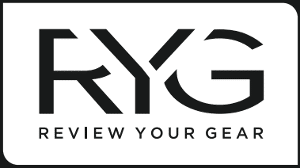Hi, my name is Chris, and I’m a crankaholic… Yes, I will admit it; I have a problem. I love to fish and when open water season warms up, I love walleye trolling. And not just trolling for walleyes, I like to take an efficient approach to my fishing. Let me explain…
First off, if you’re reading this you’re either a beginner at trolling walleyes or someone who trolls often but maybe looking for other approaches. Either way, I will cover EVERYTHING when it comes to efficient trolling for walleyes. Either you’re asking, “How to troll for walleye?” or “How Can I Be a Better Walleye Troller?” Either way, I guarantee you’ll take away from something from this article.
I’ve spent countless hours on the water perfecting my trolling, and I still feel I’m learning everyday fishing. Just when you think you’ve seen it all, the opposite can happen. Keep an open mind, and try not to get stuck in a rut of just fishing one way.
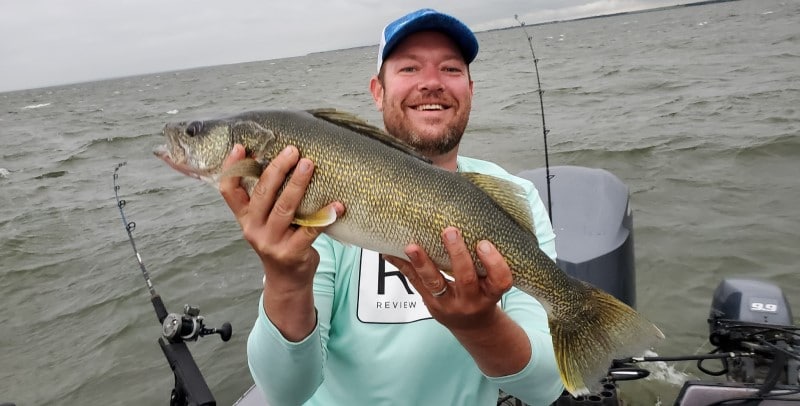
Walleye Trolling Rod Setup
I will get deep into equipment in a bit, but for now, let’s talk basics and advanced setups of trolling. Depending on the state you fish in, you can use 1 to 4 rods (that I know of) per person. In my home state of North Dakota, I can fish 2 each. With that being said, the number of walleye rods you use and how you use them can vary greatly.
The common walleye trolling setup for 2-4 rods is to spread them out around the boat (see the diagrams). Basically, you’re using the longest trolling rods you have out the sides and the shorter rods back at an angle. I use 10.5-foot walleye rods out the sides, and 5-foot “shorty” rods out of the inside when long lining all 4 rods.
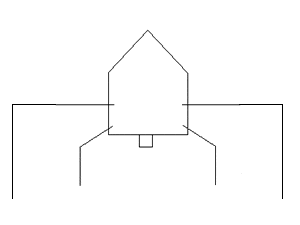
If you’re fishing 4 long lines out of one boat (without planer boards), you need to be careful. If you’re turning fast and sliding the back of the boat around, you run the risk of your outside/inside rods tangling. When that happens, it’s USUALLY a disaster.
So a tip to avoid this is to run 3-way rigs or snap weights on the inside lines. I will cover this in-depth further down when I get into using snap weights for trolling walleyes.
If you’re going to be running more then 4 rods (unless you’re running 3-ways or snap weights), you’ll probably want to look into using planer boards. Planer boards, in their simplicity, are used to carry fishing lines away from the boat. These are usually the most effective when fishing long flats as they are a bit of work to run. I will cover walleye planer boards in-depth shortly.
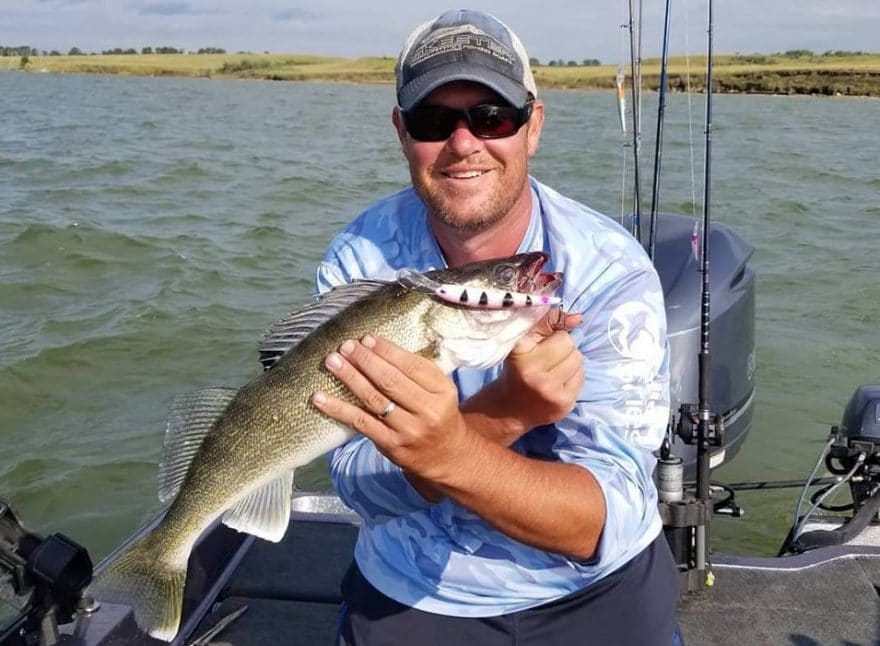
Walleye Trolling Speed
If I had to pick only one speed for walleye trolling, it would probably be around the 2 mph mark. Now that can vary throughout the year. Generally, we start slower early in the year and increase as the water warms up. This is a general rule of thumb though, so always be willing to pick it up or slow it down.
Spring & Current Fishing
For example, when I’m trolling current seams on rivers against any current, I sometimes troll as slow as 1 mph. The same goes for cold water trolling, or at times, right after cold fronts. Fish are a bit more lethargic and maybe not always willing to chase after a fast-moving walleye crankbait.
However, there are times I’ve trolled for walleyes going over 3 mph, especially in the summer when the water warms up. The fast pace of your crankbaits can cause the fish to chase and react, and high speeds can trigger bites. You really just need to play the mood of the walleyes that day.
But don’t forget to vary your speeds from time to time. Walleyes are notorious for chasing baits over long distances. Sometimes a slight slowdown or a quick speedup can cause a strike. This can be done by trolling slight zigzags (or S-curves), which naturally slows down and speeds up lures.
I do this, especially on calm water days. On windy days, the waves can create this motion automatically so I tend to drive straighter lines in waves.
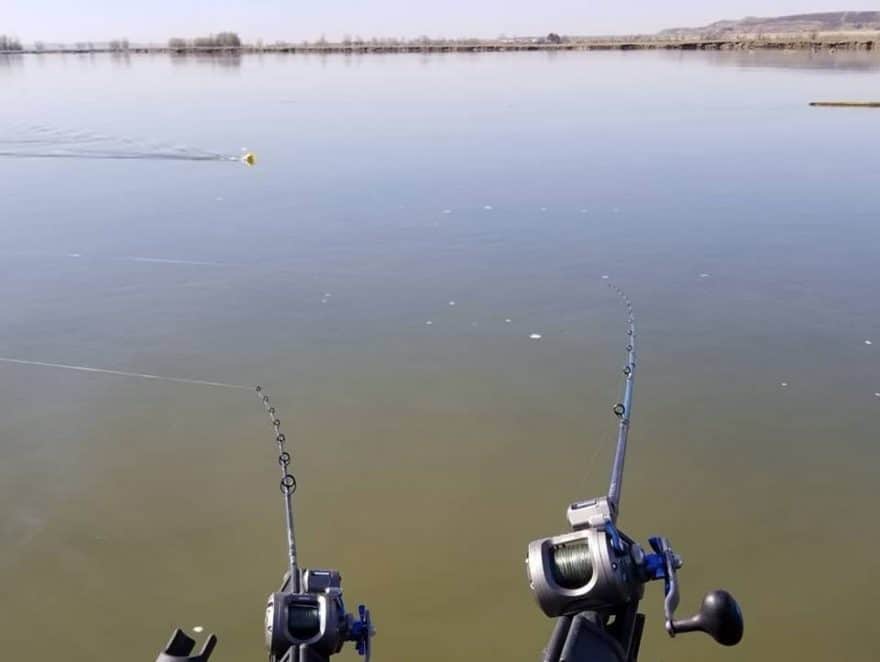
Walleye Fishing Gear
Okay, so before I get really deep into walleye trolling, we should talk proper trolling gear for walleyes. When I was a kid, we just used a rod and spinning reel and “let line out”. If I hit bottom, I reeled up a bit, etc. etc. Now, this old school way can still work, but when I talk efficiency then we have to talk about proper walleye fishing reels and rods. The key is the replicate, replicate, replicate. You’ll want the same amount of line in all of your trolling reels. That way, when a rod is hitting often at a certain length and depth, you’ll be able to dial that in with the other rods too.
Sometimes you’ll want a crankbait bouncing off the bottom, at times even suspended. Watch your electronics for clues as to where the fish are hanging out.
Walleye Trolling Reels
The most important aspect of a walleye trolling reel, in my opinion, is a line counter. Knowing how much line to have out to get your crankbait in the zone FAST can really only be done properly with line counters. So if your bait is running 75 feet back and is running a foot off the bottom and catching fish….you’ll want to replicate the length. This can only be done well with line counters PERIOD.
The next most important factor in a walleye trolling reel is the drag. With cheaper trolling reels, you’ll notice the drag is kind of touchy and weak. With proper trolling reels, they’ll be much easier to set and won’t strip or fail in the vast majority of situations. In my experience, a good walleye trolling reel starts around the $100 mark. There are some for half that, but I firmly believe in quality for reels, so I recommend the following walleye trolling reels below. I also broke down my favorite walleye trolling reels in another review. I’m leaning more and more towards the Shimano Tekotas. While they are a bit spendy, they’re just the most reliable reel on the market for trolling. And this not only includes walleye but big game fish such as pike and musky.
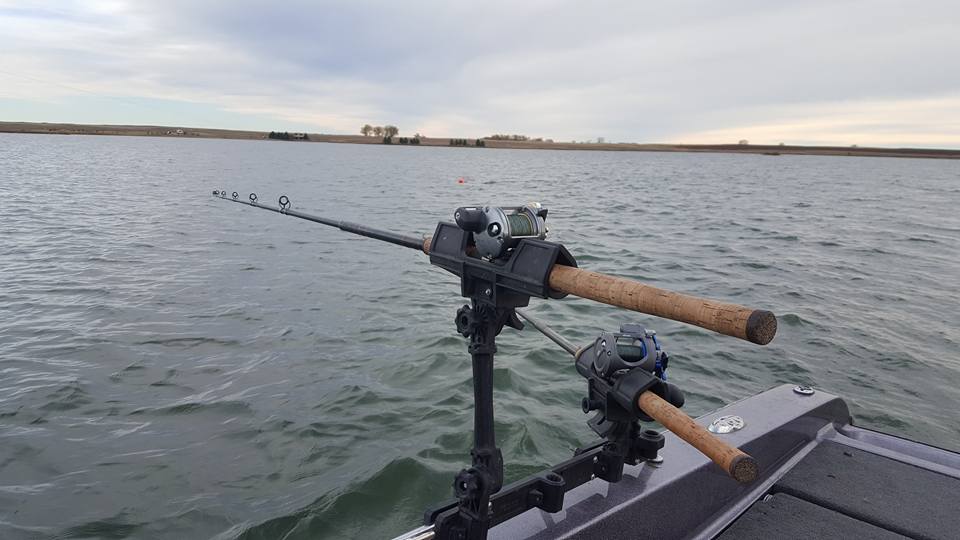
Walleye Trolling Rods
Okay so I might catch some flack for this but I don’t think you need to break the bank for good walleye trolling rods. All of my rods cost under the $150 mark, and I’m happy with ALL of them. The key is to have the right sizes.
I recommend rods around the 10-foot mark or more, along with a setup of short 5-6 foot rods. Lastly, a set of 8-foot rods for those situations where a short rod doesn’t cut it. I like to use 8-foot rods for planer boards more than the short rods. However, I like the short rods for using snap weights and 3-way rigs. It makes it easier to remove the snap weight yourself. And the LONG rods I like to long line.
Again, this is my personal preference and what works best for me. So if you’re going to save some coin on your walleye trolling gear, I would save some money and go with some options below.
Walleye Trolling Fishing Line
If you ask 10 avid walleye trollers what they use for line, there’s a good chance you’ll get 10 different answers. I see the questions about fishing line A LOT on social media, and the responses are all over the board.
Personally, I use 15 lb. Power Pro on ALL of my trolling reels. I do this for 3 reasons:
- Power Pro is the thinnest of all fishing lines, which is important for less friction in the water allowing your crankbaits to dive deeper.
- I use 15 lb. over 10 lb. just for the strength alone. We have a fair amount of snags and GIANT pike in our waters, so I need something stronger to pull through and for landing those pike. I’ve barely noticed a difference in the dive curve between 10 and 15 too. It’s just so darn thin that it cuts through the water with ease.
- It lasts long and doesn’t fray very easily. When I’ve used Fireline, for example, I find myself getting line frays which weaken it immensely. So I’m having to cut/re-tie more then I’d like to.
Again, this is my personal preference and what works for me in my neighborhood. I broke down all my favorite walleye fishing line in another review.
Walleye Trolling Crankbaits
The key to walleye trolling crankbaits is to “match the hatch” as they say. What is the forage base in the lake, river, or reservoir? What crankbaits to use can really vary from lake to lake. For example, when I fish Devils Lake in North Dakota, I like to troll small Salmo Hornets in the spring. There are a lot of young of the year white bass and crappie, and they feed on them a lot. Then when I fish 100 miles away on Lake Sakakawea in North Dakota, you’re trolling long stick baits to match the 4-inch smelt.
And that’s just the start of it all. Then you want to determine which colors are going to work best (not just the walleye crankbait size). A general rule of thumb is to use more natural colors in clear water, and bright colors in stained or dirty water. There are a TON of exceptions to this rule, however, so I advise that you tie on a lot of different colors. Once you start noticing a trend, you can start switching over the other cranks.
I have more crankbaits then I care to admit, let’s just say I’m not going to run out any time soon. But not only do you have to have a wide variety of sizes, styles, and colors…you’ll also want to have at least a couple in each color. That way you can match the situation and the crankbaits that are working.
This doesn’t come cheap, I get it. But I made it easy. I’ve already written a long review of my favorite walleye crankbaits. Check it out if you have time. That’s a great starting place for those looking to get into trolling for walleyes.
I could type for days about crankbaits. So I will leave that other review as the last place to look for crankbaits.
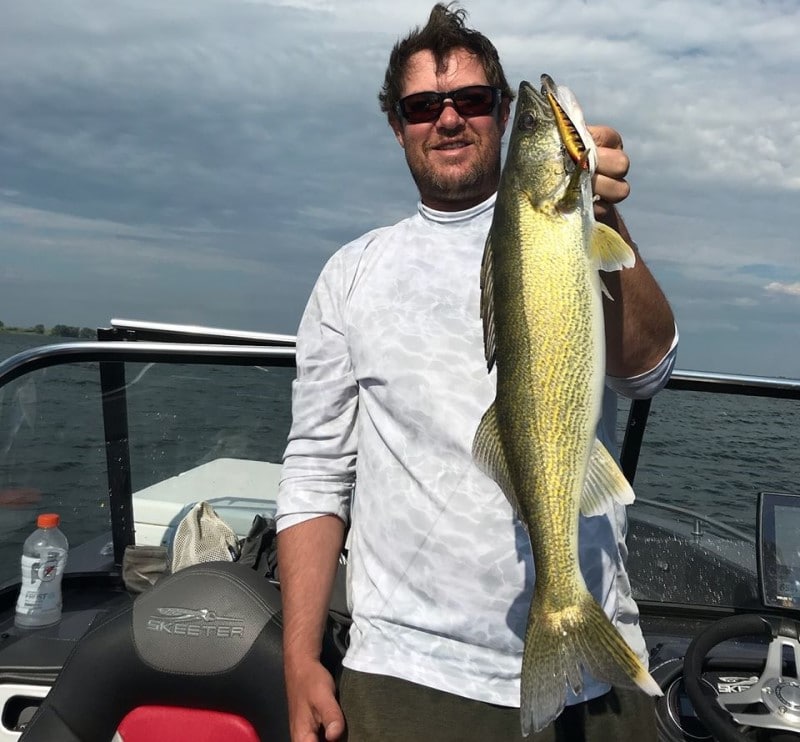
Trolling Rod Holders
I’ve also written extensively about trolling rod holders in a different review. I will just leave it there to avoid redundancy. But if you want to save time, I HIGHLY recommend Folbe Rod Holders. They’re amazing for trolling (but not the best for deadsticking). I’ve used them for over a decade now and I hate trolling without them. They “pull up”, not out, which makes landing fish easy. They do take a little getting used to, but well worth the money.
Troller’s Bible a.k.a. Precision Trolling
If you’re familiar with walleye trolling, then you should know the Troller’s Bible ( Precision Trolling Book ). The Troller’s Bible basically shows the dive curve for most every crankbait on the market for trolling walleyes. Pick your lure you want to troll, look it up in the Bible for its dive curve, and let it rock! Now keep in mind, in order to maintain closeness to the line out/depth, you’ll need to have your reels spooled properly. I run all of my reels with the exact same amount of line. For example, when using a 47 series reel, I will add 300 feet of 10 lb. mono backing, tied to 300 feet of Power Pro. Consistency is the key here, so if it’s hot with one lure at a certain line out then you can mimic that with your other rods in a flash.
The actual book is getting hard to come by these days, and if you see the listings below available, you may want to snag it up. They’re putting all their emphasis on the mobile version of Precision Trolling, and with technology these days, I can see why. But if you’re new to trolling for walleyes, this book or app is a MUST HAVE!
Walleye Planer Boards
There are a wide variety of planer boards on the market today for fishing walleyes. They really all do the same thing, but some have better features and are a bit more rugged, in my opinion. Those that I recommend are below.
Planer boards take some practice to get the hang of them. I’ve taught many, many walleye anglers how to fish planer boards and it comes down to a few simple tips.
- Have your rod tip up in the air when running planner boards. Make it go straight to the board without dragging in the water.
- Invest in the “taddle flag” options whenever possible. The flag is triggered by what’s going on with the fishing line. So if you’re hitting bottom, dragging weeds, etc. you can see it on the flag when you often can’t see it on a standard planer board.
- If running more then one planer board on a side, then make sure you space them out accordingly. When a fish hits a board, let it slide back behind in the inner rods and bring it straight into the boat. I will stress, running multiple planer boards per side takes a lot of practice. I recommend starting with one per side and add more later.
- I like to use smaller planer boards when using small baits in calm conditions. The larger boards fair better with bigger baits so it literally doesn’t pull the board under.
- Like I stated earlier, some types of fishing line can “slip” on the standard red clips that come on planer boards. If you’re getting the Off-Shore brand of planer boards, make sure you it either has the “Tension Release Clip” or buy it separately. Than you’re guaranteed that the line will not slip. Otherwise, you can double wrap the clip (2 loops), but I prefer just one.
Planer boards should be in your boat if you troll for walleye.
Snap Weights / 3-way Rigging
One of the most underused tools available on the market today for walleye trolling has to be the use of snap weights. Snap weights are simple, you clip on a weight onto your fishing line away from your crankbait. This allows lures of smaller size and in shorter lengths to get down in the water columns.
I use snap weights pretty much all the time unless I’m really shallow. The key is finding the right leader length for your trolling. Lately, I’m now using around 21 to 25 feet of leader. That means simply, you let out around 25 feet of line before you clip on the snap weight. This is long enough to keep the weight away from the bait (to eliminate spooking fish), and also it allows you to take off the clip without affecting the landing of the fish. I like to use heavy weights myself, with 3-5 oz. weights being my most commonly used.
I used to use A LOT of 3-way swivels for my walleye trolling. Basically, I tie on to a 3-way swivel, and on the next end, I tie on about 6 feet of 10 lb.of Fluorocarbon line or Fireline Crystal leader (depending on water clarity). On the 3rd end, I clip on a 4 to 5 oz. snap weight. It allows my rig to act like a downrigger and get my lure down FAST below the boat and into the zone. I use a 5 oz weight because I like to have my line around 45 degrees down below the boat. The reason I got away from 3-ways is I fish a lot of clear water and I thought the weight was spooking fish.
Yes, that’s pretty close to the motor but you’d be surprised how many fish we catch this way. It will outfish the long lines A LOT of the time. To set it out, simply let out the fishing line and when it hits bottom, you’re about done. Depending on your speed, it’ll drag it out 45 degrees and keep the lure right off the bottom (weight a couple feet up and 25 feet away). The deeper diving cranks you’ll need to reel in more to keep the crankbait from bouncing too much on the bottom.
Kind of like planer boards, it does take a little bit of practice. But I use these often on the inside rods on the boat. This way, it won’t tangle with the outside rod when turning sharp. Try using this, I guarantee you that you’ll be using it often.
Leadcore Trolling for Walleyes
When mid to late summer kicks in, and even early fall, walleyes tend to slide deep. I know every body of water is different, but in my neck of the prairie, this is the way it is. When late July through September rolls in, you’ll typically find me fishing deep for walleyes. And when I say deep I mean between 25-40 feet (always exceptions). In order to troll deep for walleyes, you need to do one of three things basically:
- Fish BIG lipped crankbaits that can dive that deep, typically the biggest baits you’ll find at the store.
- You can fish snap weights or 3-way rigs for trolling walleyes.
- You can fish leadcore.
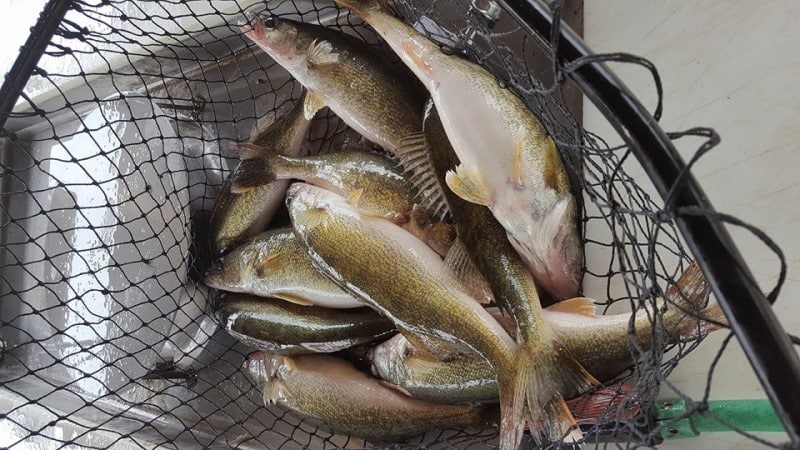
Let me paint a scenario where leadcore was key. I was fishing Mille Lacs in Minnesota a few years back in mid-August. Basically, everyone said it was only a night bite. Well being the stubborn Norwegian that I am I had to prove it wrong. We started trolling the deepest basin via leadcore and ran #5 Rapala Shap Raps in White Perch. They weren’t hitting ANYTHING else. The water is crystal clear and you needed to have a long leader. Nothing else was cutting it, they wanted baits that size and without any clutter.
So what is leadcore? Basically, it’s lead-filled line that sinks in the water. Usually, leadcore comes in lengths that are 8 colors. Every color you let out, it sinks about 5 feet. So even without line counters, you can count via colors to get to the desired depth. You’ll want a bigger series trolling reel to fit all that line. I’m typically finding only use size #47 Reels when fishing leadcore for walleyes.
Usually, I use leadcore when I want to get small baits deep. It’s not necessarily the prettiest way to fish, but it flat out works. Leadcore for walleyes is something you should be prepared for in the summer and early fall. Once you figure it out, you’ll find yourself using it more often I guarantee you.
Trollmaster
If you fish with a kicker motor for trolling for walleyes, then I highly suggest you invest in a Trollmaster if you don’t already have one. What is a Trollmaster? It’s basically a remote control that’s connected to your kicker motor. You can control your RPMs, and dial in the speed you desire for trolling walleyes. This way, you’re not tiring out your throttle by speeding up/slowing down all day. I literally cannot fish without one. I use the Trollmaster Pro 2 and it also has a Max Speed button so you can trigger bites literally at the push of a button (yes, it has other uses too). I would look into these if you haven’t already.
The only downside, is I haven’t had one last for more than 2-3 years. Something always burns up inside, unfortunately. But I still install another each time because like I stated, I can’t troll without it.
Misc. Walleye Trolling Tips
There are some simple tips that I included that you should definitely know if you’re planning to do some heavy trolling.

Split Shots
There are days on the water, where using split shots proves to be invaluable. If there’s a lot of debris floating on the water, it will catch and run down your fishing line. It ends up on your crankbait, causing it to foul up. That’s where split shots come in… I like to place small split shots about 2 to 3 feet above the lure. They literally catch the debris, keeping your crank clean. A simple tip to a complex problem for sure. You will want to clean up the debris occasionally, but hopefully, you’re catching enough fish where it won’t even matter. 🙂

Driving the Boat
Okay so this is where I get a tad anal, and I will apologize now for it as I don’t mean to criticize anyone. I’ve had a lot of guys in my boat that take the wheel while walleye trolling, and it usually ends up disastrous. Let’s say you’re in 15 feet of water catching fish, and you want to stay at that depth. When guys spend the whole time cutting in and out from 10 to 20 (or more) it drives me nuts. Driving a boat is not hard, precision trolling at a particular depth is REALLY important. Use the mapping available on your electronics, zoom in, and pay attention to the arrow in front of you. Anticipate breaks, and stay a step ahead. Don’t wait until you’re “off” to cut back…anticipate.
Also, it really helps more often than not, to troll WITH the wind instead of against it. Not only is it easier, but I always feel it’s the natural direction bait is moving as well. Also, the stop and go action of waves causes reaction strikes. In other words, seek out windblown shorelines and try trolling them first.
Lastly, on driving, slight zig zags (or S Curves) will help you catch more fish. The cutting action causes crankbaits to speed up and slow down. Walleyes or any predators for that matter, that are chasing your bait will react to the change in speed. Mix it up, change speeds often.
So at the end of the day, walleye trolling can be as complex and as simple as you need it to be, depending on the situation. As you can see in the video where I’m fishing with my kids, walleye trolling is fun for kids and easy to learn and master. Take some time this year and take a kid fishing, you’ll be glad you did.
